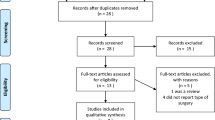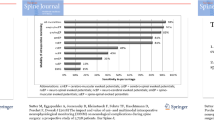Abstract
Purpose
The objective is to compare the intraoperative monitoring (IOM) outcomes between degenerative cervical and thoracic spine decompression surgery.
Method
A total of 97 patients with cervical compression myelopathy (CCM) and 75 patients with thoracic compression myelopathy (TCM) were prospectively collected between December 2012 and June 2015 in our spine center. Somatosensory-evoked potentials (SSEP) and motor-evoked potentials (MEP) were used for IOM. The postoperative neurologic status of each patient was assessed immediately after surgery. And the IOM and neurological outcomes were mainly analyzed in this study.
Results
Under the same alarm criteria, the IOM changes present significant difference between the cervical and thoracic surgery. During the patients with monitoring alerts, the MEPs usually manifest as sudden loss in TCM whereas the gradual loss in CCM. And there were three permanent neurologic injuries in the thoracic cases, but none in cervical cases.
Conclusion
The IOM loss between CCM and TCM patients present obvious difference and the sudden MEPs loss associated with spinal decompression need to be taken seriously especially in TCM.


Similar content being viewed by others
References
Wang S, Yang Y, Zhang J, Tian Y, Shen J, Wang S (2016) Frequent neuromonitoring loss during the completion of vertebral column resections in severe spinal deformity surgery. Spine J. doi:10.1016/j.spinee.2016.08.002
Wang S, Zhuang Q, Zhang J, Tian Y, Zhao H, Wang Y, Zhao Y, Li S, Weng X, Qiu G, Shen J (2015) Intra-operative MEP monitoring can work well in the patients with neural axis abnormality. Eur Spine J. doi:10.1007/s00586-015-4205-6
Wang S, Tian Y, Zhang J, Shen J, Zhao Y, Zhao H, Li S, Yu B, Weng X (2015) Intraoperative motor evoked potential monitoring to patients with preoperative spinal deficits: judging its feasibility and analyzing the significance of rapid signal loss. Spine J. doi:10.1016/j.spinee.2015.09.028
Wang S, Zhang J, Tian Y, Shen J (2016) Rare true-positive outcome of spinal cord monitoring in patients under age 4 years. Spine J. doi:10.1016/j.spinee.2016.05.002
Taher F, Lebl DR, Cammisa FP, Pinter DW, Sun DY, Girardi FP (2013) Transient neurological deficit following midthoracic decompression for severe stenosis: a series of three cases. Eur Spine J 22:2057–2061. doi:10.1007/s00586-013-2829-y
Eggspuehler A, Sutter MA, Grob D, Porchet F, Jeszenszky D, Dvorak J (2007) Multimodal intraoperative monitoring (MIOM) during surgical decompression of thoracic spinal stenosis in 36 patients. Eur Spine J 16(Suppl 2):S216–S220. doi:10.1007/s00586-007-0425-8
Kaneko K, Sakamoto S, Toyoda K, Kato Y, Taguchi T (2006) False negative in spinal cord monitoring using spinal cord-evoked potentials following spinal cord stimulation during surgery for thoracic OPLL and OLF. J Spinal Disord Tech 19:142–144. doi:10.1097/01.bsd.0000171628.93245.13
Sakaki K, Kawabata S, Ukegawa D, Hirai T, Ishii S, Tomori M, Inose H, Yoshii T, Tomizawa S, Kato T, Shinomiya K, Okawa A (2012) Warning thresholds on the basis of origin of amplitude changes in transcranial electrical motor-evoked potential monitoring for cervical compression myelopathy. Spine 37:E913–E921. doi:10.1097/BRS.0b013e31824caab6
Hilibrand AS, Schwartz DM, Sethuraman V, Vaccaro AR, Albert TJ (2004) Comparison of transcranial electric motor and somatosensory evoked potential monitoring during cervical spine surgery. J Bone Joint Surg Am 86-A:1248–1253
Ukegawa D, Kawabata S, Sakaki K, Ishii S, Tomizawa S, Inose H, Yoshii T, Kato T, Enomoto M, Okawa A (2014) Efficacy of biphasic transcranial electric stimulation in intraoperative motor evoked potential monitoring for cervical compression myelopathy. Spine 39:E159–E165. doi:10.1097/BRS.0000000000000082
Clark AJ, Ziewacz JE, Safaee M, Lau D, Lyon R, Chou D, Weinstein PR, Ames CP, Clark JP 3rd, Mummaneni PV (2013) Intraoperative neuromonitoring with MEPs and prediction of postoperative neurological deficits in patients undergoing surgery for cervical and cervicothoracic myelopathy. Neurosurg Focus 35:E7. doi:10.3171/2013.4.FOCUS13121
Wang S, Tian Y, Wang C, Lu X, Zhuang Q, Peng H, Hu J, Zhao Y, Shen J, Weng X (2016) Prognostic value of intraoperative MEP signal improvement during surgical treatment of cervical compressive myelopathy. Eur Spine J. doi:10.1007/s00586-016-4477-5
Wang S, Tian Y (2016) Exploration of the intraoperative motor evoked potential. Spine 41:470–475. doi:10.1097/BRS.0000000000001240
Muramoto A, Imagama S, Ito Z, Ando K, Tauchi R, Matsumoto T, Nakashima H, Matsuyama Y, Ishigro N (2014) The cutoff amplitude of transcranial motor evoked potentials for transient postoperative motor deficits in intramedullary spinal cord tumor surgery. Spine 39:E1086–E1094. doi:10.1097/BRS.0000000000000421
Macdonald DB, Skinner S, Shils J, Yingling C, American Society of Neurophysiological M (2013) Intraoperative motor evoked potential monitoring—a position statement by the American Society of Neurophysiological Monitoring. Clin Neurophysiol 124:2291–2316. doi:10.1016/j.clinph.2013.07.025
Zhuang QY, Wang SJ, Zhang JG, Zhao H, Wang YP, Tian Y, Zhao Y, Li SG, Weng XS, Qiu GX, Shen JX (2014) How to make the best use of intraoperative motor evoked potential monitoring? Experience in 1162 consecutive spinal deformity surgical procedures. Spine 39:E1425–E1432. doi:10.1097/Brs.0000000000000589
Balzer JR, Rose RD, Welch WC, Sclabassi RJ (1998) Simultaneous somatosensory evoked potential and electromyographic recordings during lumbosacral decompression and instrumentation. Neurosurgery 42:1318–1324 (discussion 1324–1315)
Thirumala PD, Bodily L, Tint D, Ward WT, Deeney VF, Crammond DJ, Habeych ME, Balzer JR (2014) Somatosensory-evoked potential monitoring during instrumented scoliosis corrective procedures: validity revisited. Spine J 14:1572–1580. doi:10.1016/j.spinee.2013.09.035
Holdefer RN, MacDonald DB, Skinner SA (2015) Somatosensory and motor evoked potentials as biomarkers for post-operative neurological status. Clin Neurophysiol 126:857–865. doi:10.1016/j.clinph.2014.11.009
Raynor BL, Padberg AM, Lenke LG, Bridwell KH, Riew KD, Buchowski JM, Luhmann SJ (2016) Failure of intraoperative monitoring to detect postoperative neurologic deficits: a 25-year experience in 12,375 spinal surgeries. Spine 41:1387–1393. doi:10.1097/BRS.0000000000001531
Kobayashi K, Imagama S, Ito Z, Ando K, Hida T, Ishiguro N (2016) Prevention of spinal cord injury using brain-evoked muscle-action potential (Br(E)-MsEP) monitoring in cervical spinal screw fixation. Eur Spine J. doi:10.1007/s00586-016-4941-2
Lee JM, Kim DH, Kim HS, Choi BK, Han IH (2016) The applicability of intraoperative neuromonitoring in patients with preoperative motor weakness during spine surgery. Korean J Spine 13:9–12. doi:10.14245/kjs.2016.13.1.9
Martirosyan NL, Feuerstein JS, Theodore N, Cavalcanti DD, Spetzler RF, Preul MC (2011) Blood supply and vascular reactivity of the spinal cord under normal and pathological conditions. J Neurosurg Spine 15:238–251. doi:10.3171/2011.4.SPINE10543
Owen JH, Bridwell KH, Grubb R, Jenny A, Allen B, Padberg AM, Shimon SM (1991) The clinical application of neurogenic motor evoked potentials to monitor spinal cord function during surgery. Spine 16:S385–S390
Shamji MF, Maziak DE, Shamji FM, Ginsberg RJ, Pon R (2003) Circulation of the spinal cord: an important consideration for thoracic surgeons. Ann Thorac Surg 76:315–321
Novak K, Widhalm G, de Camargo AB, Perin N, Jallo G, Knosp E, Deletis V (2012) The value of intraoperative motor evoked potential monitoring during surgical intervention for thoracic idiopathic spinal cord herniation. J Neurosurg Spine 16:114–126. doi:10.3171/2011.10.SPINE11109
Hamilton DK, Smith JS, Sansur CA, Glassman SD, Ames CP, Berven SH, Polly DW Jr, Perra JH, Knapp DR, Boachie-Adjei O, McCarthy RE, Shaffrey CI, Scoliosis Research Society M, Mortality C (2011) Rates of new neurological deficit associated with spine surgery based on 108,419 procedures: a report of the scoliosis research society morbidity and mortality committee. Spine 36:1218–1228. doi:10.1097/BRS.0b013e3181ec5fd9
Cole T, Veeravagu A, Zhang M, Li A, Ratliff JK (2014) Intraoperative neuromonitoring in single-level spinal procedures: a retrospective propensity score-matched analysis in a national longitudinal database. Spine 39:1950–1959. doi:10.1097/BRS.0000000000000593
Traynelis VC, Abode-Iyamah KO, Leick KM, Bender SM, Greenlee JDW (2012) Cervical decompression and reconstruction without intraoperative neurophysiological monitoring Clinical article. J Neurosurg-Spine 16:107–113. doi:10.3171/2011.10.SPINE11199
Author information
Authors and Affiliations
Corresponding author
Ethics declarations
Conflict of interest
The author declares that there is no competing interest.
Rights and permissions
About this article
Cite this article
Wang, S., Tian, Y., Lin, X. et al. Comparison of intraoperative neurophysiologic monitoring outcomes between cervical and thoracic spine surgery. Eur Spine J 26, 2404–2409 (2017). https://doi.org/10.1007/s00586-017-5194-4
Received:
Revised:
Accepted:
Published:
Issue Date:
DOI: https://doi.org/10.1007/s00586-017-5194-4




